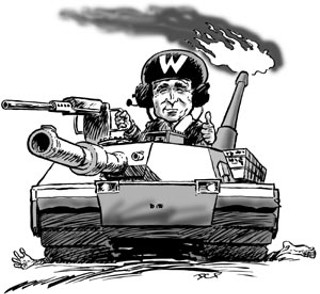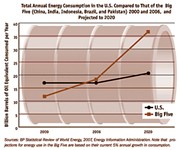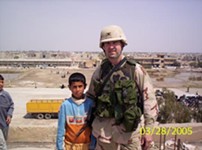The Military-Petroleum Complex
The Second Iraq War and the cronies of state capitalism
By Robert Bryce, Fri., June 18, 2004

Twelve years after the end of the First Iraq War, George H. W. Bush was still reading from the same script.
On March 25, 2003 – five days after the Navy SEALs stormed aboard the Mina al-Bakr oil terminal to start the Second Iraq War – the former president gave a speech at the Marriott Rivercenter Hotel in San Antonio. His audience: the National Petrochemical and Refiners Association.
Bush Senior was a little peeved. Not at his allies in the oil and chemical industry, of course. The National Petrochemical and Refiners Association, a group whose membership includes "virtually all U.S. refiners and petrochemical manufacturers," was a friendly audience. He was angry at those misguided protesters who were staging huge antiwar rallies all over the country. Those demonstrators had gotten under Bush's skin. He was particularly inflamed by the signs that the demonstrators were carrying that said "No war for oil." Bush said he'd seen similar protests and similar signs prior to the First Iraq War. And now that the Second Iraq War was under way, he was still contending that the protesters were mistaken. "This is not about oil," he told the refiners.
At about the same time the elder Bush was delivering that message, U.S. and British troops were in a furious battle with Iraqi tank companies for control of the Rumaila, Majnoon, Qurnah, and Nahr Umr oilfields near Basra. Those four fields contain an estimated 51 billion barrels of oil. As Bush was speaking to the refiners, firefighters from the Kuwait Oil Company were snuffing out the flames at one of the seven oil wells near Basra that had been set aflame by forces loyal to Saddam Hussein. At about the same time, 1,000 troops from the 173rd Airborne Brigade were being airlifted into northern Iraq. Their task was to capture the oilfields around Kirkuk. The troops were being backed up by American warplanes, which were beginning to bomb Iraqi strongholds around Kirkuk. The oilfields around Kirkuk hold about 16 billion barrels of oil.
While U.S. troops were invading the oilfields, the younger Bush, from his perch in the White House, refused to even discuss the oil question. Instead, the president's focus was on the evils of Saddam Hussein and his alleged weapons of mass destruction program. Bush talked about Saddam's "nucular" weapons and claimed that the Iraqi dictator had huge stashes of VX, sarin, and mustard gas that had to be found and destroyed. And while George W. Bush continued his stream of rhetorical attacks on Iraq, his key aides were looking at Iraq's oil and seeing it as a massive piggy bank. They dreamt of a type of drive-through-pay-for-itself-car-wash type of war.
A Pipeline to Zion On March 27, two days after Bush Senior spoke to the refiners, Deputy Defense Secretary Paul Wolfowitz testified before Congress about the rapidly progressing war. Wolfowitz, one of the leaders of the neoconservative movement, which believes America has a duty to dominate the world, told Congress that the Second Iraq War wouldn't be overly expensive for American taxpayers. "We're dealing with a country that can really finance its own reconstruction, and relatively soon," he told Congress. Asked how much the Second Iraq War would cost, Wolfowitz stuttered out: "And my – a rough recollection – well I'm – the oil revenues of that country could bring between 50- and 100-billion dollars over the course of the next two or three years."
Alas, Wolfowitz hadn't done his homework. Or – and let's hope this wasn't the case – he was telling a stretcher. Even the most optimistic oil experts were projecting that Iraq's oilfields would be hampered for some time to come as a result of a lack of investment in infrastructure. At best, they estimated that Iraq's oilfields were capable of producing revenues of only about $10 billion per year.
But Wolfowitz couldn't trouble himself with learning the facts. Instead, he and his fellow neoconservatives were figuring out how they could divvy up the spoils of war. Within a few days of his outlandish estimates of Iraq's oil wealth, other pro-Israel hawks inside the Pentagon began talking to the Israelis about building a pipeline from the Iraqi oilfields near Kirkuk to the Israeli port of Haifa. A small pipeline had operated along that route in the 1940s, and the neocons apparently believed that it was time to build a pipeline from the heart of Arabia to the heart of the Zionist homeland.
Ensuring a reliable supply of oil to its ally Israel had been one of America's main obligations in the region for nearly three decades. In 1975, Henry Kissinger signed an agreement that requires the U.S. to guarantee the flow of oil to Israel during times of crisis. Kissinger was also a key architect of the plan, pushed by Donald Rumsfeld when he met with Saddam Hussein in 1983, to build a pipeline from Iraq to the Jordanian port of Aqaba.
America's oil supply agreement with the Israelis has been renewed every five years. The deal requires the United States to supply oil to Israel even if it causes domestic shortages of oil in America. Although the U.S. has not ever had to make good on the agreement, a pipeline, reasoned the neocons, could help secure Israel's energy needs, and provide another way to ship Iraqi oil to the markets and shipping lanes on the Mediterranean Sea. The pipeline would have huge economic benefits to the Israelis, lowering their oil import bills by as much as 25 percent. The Israelis even began estimating what the pipeline would cost. Unfortunately, a pipeline from Iraq to Israel also would have been a diplomatic disaster. For decades, the Arab oil-producing countries have been objecting to America's ongoing support of the Israelis. And the idea of running a pipeline through Jordan (nearly impossible from a political standpoint) or Syria (absolutely impossible politically) so that the Israelis could have cheap Arab oil, would have been met with outrage by Arab leaders – and a fusillade of terrorists' bombs in their countries.

When news about the pipeline project began surfacing in the British media in April of 2003, James Akins, a former U.S. ambassador to Saudi Arabia, said the plans laid bare America's real motives. "It just goes to show that it is all about oil, for the United States and its ally," he said.
At the same time that the United States was chatting up the Israelis about a pipeline, American troops had subdued Baghdad. But the soldiers made only token efforts to secure Baghdad's cultural treasures and stop the looting that started as soon as the city fell. The result was horrifying. Government offices were ransacked. Stores were looted. Saddam Hussein's palaces were stripped of furniture and fixtures. The National Library of Iraq, the National Archives, and the central libraries of the Universities of Baghdad and Mosul were all looted and burned. Priceless manuscripts, documents, and books were lost. The National Museum of Antiquities was also looted. Assyrian marble carvings, Babylonian statues, and clay pots thousands of years old were all smashed to bits.
The Oil Ministry building, however, wasn't touched. That was not a coincidence. One of the first sites secured by American troops after they got to Baghdad on April 8 was the Oil Ministry building. For the next few days, as the looting continued all around the city, a detachment of American G.I.s with a half dozen assault vehicles stood guard at the Oil Ministry building. On April 13, 2003, the Washington Post quoted one Iraqi citizen who asked why the looting was allowed in other buildings and not in the Oil Ministry: "Why just the Oil Ministry?" he asked. "Is it because they just want our oil?" Three days later, Agence France Presse reported that some four dozen U.S. tanks were guarding the ministry building and that "sharpshooters are positioned on the roof and in the windows."
The Costs of Empire
By early June of 2003, Halliburton's technicians were clambering all over Iraq's oil facilities, assessing the damage and making repairs. One of their first stops was Mina al-Bakr. Halliburton did its job well. In late June 2003, about eight weeks after George W. Bush's May 1 "mission accomplished" declaration aboard the USS Abraham Lincoln that "major combat operations in Iraq have ended," the country's black gold began to flow. The pipeline from the oilfields near Kirkuk to the Turkish port at Ceyhan began carrying crude.
But the first big shipments of Iraqi oil didn't begin until June 28, 2003. On that day, the first supertanker to load Iraqi crude in the post-Saddam era began filling up at Mina al-Bakr. The buyer of the oil was Condoleezza Rice's old employer, ChevronTexaco. A few dozen hours later, the tanker, loaded with two million barrels of crude known as Basra Light, left Mina al-Bakr and headed straight for refineries – in the United States. Over the next few months, dozens of other supertankers begin filling their holds with Iraqi oil, and the majority of those tankers headed for the United States.
With U.S. troops guarding the Iraqi Oil Ministry in downtown Baghdad and Halliburton employees manning the controls at Mina al-Bakr and other oil facilities, the Bush administration had achieved its goal: the second-largest oil reserves on earth were under the control of the United States. Nearly 30 years after OPEC shut off the flow of oil to America in retaliation for its support of the Israelis, the U.S. had gained a measure of control over Persian Gulf oil supplies. And it had done it behind the barrel of a gun.
Governor Ross Sterling of Texas would have understood the situation perfectly. There were key differences, however, between the American invasion of Iraq and Sterling's 1931 takeover of the oilfields of East Texas. Sterling's operation came cheap: just 1,200 National Guardsmen were needed to control the region's oilfields. The cost of the campaign was less than $30,000 per week (about $357,100 in 2002 dollars). There were no casualties – in fact, not a single person was hurt. The Texas Rangers made only a handful of arrests. And the action was quick: all of the Guardsmen were back home with their families by December of 1932, a mere 16 months after the action began. The only casualty of the campaign occurred several months after the Guardsmen went home. In the summer of 1933, a Texas Ranger, Emmett White, was killed outside of Kilgore in an accident involving an oil truck.
Seventy-two years after Sterling's forces invaded East Texas, another Texas governor was having a far harder time gaining control of a critically important oil-producing area. To win the Second Iraq War, George W. Bush deployed some 140,000 American soldiers and 21,000 soldiers from Britain and other countries to Kuwait and Iraq.
The costs were extraordinary: during the war, an estimated 10,000 Iraqis were killed. Between the start of hostilities in March 2003 and mid-January 2004, more than 500 American GIs were killed and another 9,000 had been injured in battle, hurt in accidents or had become seriously ill. Sabotage, snipers and almost-daily car bombings were testing the will and patience of America's soldiers and their commanders.
The financial costs were mind-numbing. By the end of 2003, the occupation of Iraq was costing American taxpayers about $1 billion per week, and that figure was only part of their financial burden. Rebuilding Iraq and maintaining the peace were costing even more. Those costs were going to be huge, even though none of George W. Bush's stated reasons for going to war – Saddam's "nucular" weapons, his stashes of poison gas, and his links to al-Qaeda and terrorism – had been found. By early 2004, despite months of frantic searching, American investigators had not found any evidence that Iraq had weapons of mass destruction. Even after Saddam Hussein was found on December 14, 2003, and questioned by U.S. interrogators, no weapons of mass destruction were found.
The Man From Halliburton
In September of 2003, George W. Bush asked the U.S. Congress to approve an $87 billion spending package to pay for the war and for reconstruction efforts in Iraq. Not surprisingly, a big chunk of that money was going to Dick Cheney's old company, Halliburton.
When Bush went to Congress, Halliburton had already been paid about $2 billion for its work in Iraq. The company had 4,500 people on its payroll, though it was hard to tell the Halliburton employees from the U.S. military. Some were working at oil installations like Mina al-Bakr. Others were delivering mail to U.S. troops. Others were cooking meals, doing laundry, and building military bases. Like the soldiers, Halliburton employees were dying. By January 2004, more than a dozen Halliburton workers or subcontractors had been killed while carrying out their duties in Iraq.
For his part, Dick Cheney went on television in September of 2003 to defend his ongoing payments from Halliburton. Cheney insisted that he had "no financial interest in Halliburton of any kind." This was incorrect: When Cheney made that statement, he still had options on about 433,000 shares of Halliburton stock. He was also in the second year of a five-year deferred-compensation deal with Halliburton. In 2002, Cheney received deferred compensation payments from Halliburton that totaled $162,392. That sum was on top of the $205,298 in deferred compensation that Cheney received in 2001. As vice president, Cheney's annual salary is $198,600.
Cheney also defended his old employer, saying he had "no idea" why Halliburton got the no-bid oilfield-repair contract. But he did say that there are "few companies out there that have the combination of the very large engineering construction capability and significant oil field services." In other words, after decades of getting closer and closer to the U.S. government and the U.S. military, Halliburton had become the Pentagon's only choice. It could feed troops, build camps, fix pipelines, repair oil wells, and do everything else America's army of occupation needed. In Iraq, Halliburton became example 1A of what the economist James Kenneth Galbraith has called the "military-petroleum complex."
In Iraq, the U.S. government, the military, corporate America, and the oil business became one. ![]()
From the book Cronies: Oil, the Bushes, and the Rise of Texas, America's Superstate by Robert Bryce. Copyright © 2004. Reprinted by arrangement with PublicAffairs, New York. All rights reserved.
Got something to say on the subject? Send a letter to the editor.








